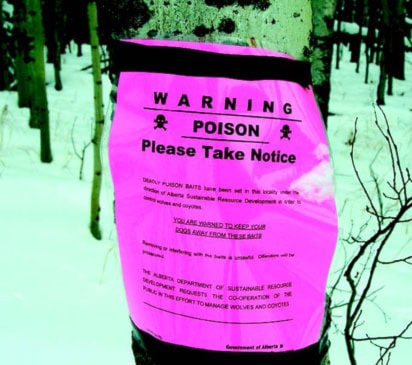Using poison to kill wolves suspected of preying on livestock in West Central Alberta continues.
Fish and Wildlife officers have been laying out bait laced with strychnine in the Medicine Lake area and most recently in the Buck Mountain grazing reserve — a practise that has raised the ire of Central Alberta biologist Myrna Pearman.
On Wednesday, Alberta Justice and Solicitor General spokesman Brendan Cox said one poison site remains and that’s in the Medicine Lake area. It’s located about 25 km northwest of Rimbey.
A sign was posted inside the Town Creek Natural Area warning users of the presence of poison baits to kill wolves and coyotes. This area is about 30 km north of Rimbey on Hwy 20’s east side.
Like Alberta’s nearly 150 other natural areas, the 640 acres inside Town Creek are government-owned and protected lands preserving Alberta’s biological and physical diversity.
None of the poison was set in the natural area.
“The access road to one of the (poison) sites went through the Town Creek Natural Area,” said Cox.
Some bait had been placed in the Buck Mountain area, but was removed earlier this month. It’s located 25 km north of Winfield, which is west of Wetaskiwin.
Five wolves died from the poison bait there, said Cox.
Pearman wrote a letter on Jan. 9 to Diana McQueen, the province’s Environment and Sustainable Resources minister, asking why poison control is necessary, why the public pays for predator control on public lands when only grazing leaseholders benefit and why Alberta Tourism, Parks and Recreation, which administers natural areas, wasn’t informed of the program.
Pearman said she’s disappointed she hasn’t heard back.
“And I think that speaks volumes as to how our government listens to its citizens,” said Pearman this week.
A spokesperson for the minister's office said on Friday that Pearman would soon be receiving a written response.
Cox said the poison bait is monitored daily and is left there for only a matter of days before it’s removed. Signs are placed around to make sure people don’t go in there, he added.
“When they place bait out, they’re targeting a specific pack of wolves,” said Cox.
If wolves appear to be hunting livestock, the officers will place some roadkill out of sight and will then see if the wolves will feed on it. Then they know if the wolves are in the area.
“If (the bait) is being fed on by non-targeted species or is not being fed on by the wolves, then they won’t go ahead with it,” said Cox.
This practice of placing poisonous bait out for wolves starts to wind down around now as wolves get into breeding season and they tend to be more erratic as to where they may go, he added.
ltester@www.reddeeradvocate.com
